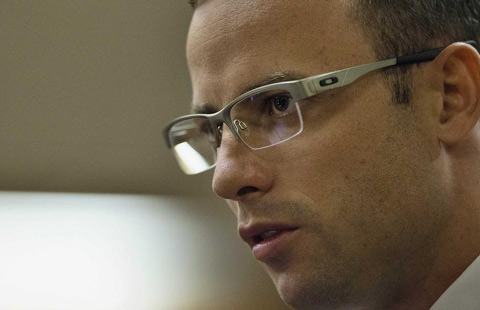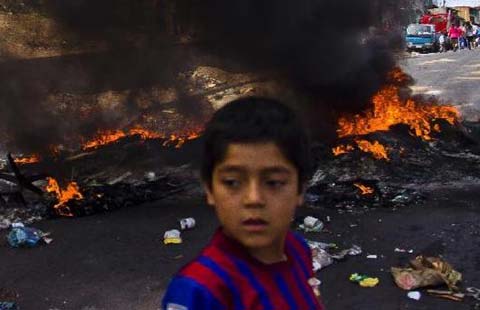
|
Ding Zhenglan, 85, a survivor of the Nanjing Massacre, cleans a frame containing photos of her late husband Li Jun. Yang Xi / For China Daily |
|
A map shows the 4-square-kilometer safety zone in the city which consisted of 25 locations. Provided to China Daily |
A theater performance revives memories of the horrors of the Nanjing Massacre
"My greatest hope is that this book will inspire other authors and historians to investigate the stories of the Nanking survivors before the last of the voices from the past, dwindling in number every year, are extinguished forever."
The voice of the writer of those words, Iris Chang, would itself be lost to the world seven years after she wrote them, when she killed herself at the age of 36 in 2004.
But Chang and her testimony are being heard strongly again this week as The Trial of Hirohito, a mock trial of the Japanese wartime leader, is staged at the Mojo Theater in San Francisco.
Chang wrote the bestselling book The Rape of Nanking, which when it was published in 1997 brought worldwide attention to an atrocity 60 years earlier in which invading Japanese soldiers killed at least 300,000 Chinese civilians and unarmed soldiers over a period of six weeks in the city now called Nanjing.
Another figure in the stage presentation is John Rabe, a German businessman credited with saving thousands of lives in Nanjing, and who has been likened to Oskar Schindler, the German industrialist who saved hundreds of Jews from death in Poland in World War II.
A well kept diary of Rabe over thousands of pages was a boon to Chang in writing the book, a mission motivated partly by stories her grandparents, who escaped the massacre, had recounted.
One of the first people she turned to to try to better understand the massacre was Shao Ziping, a United Nations official living in New York.
Shao, born in Nanjing in 1936, the son of a Nationalist government envoy in Yokohama, has worked for decades to raise awareness of the slaughter and is the founder of the Chinese Alliance for Memorial and Justice and the Alliance in Memories of Victims of the Nanking Massacre.
"I told Iris about John Rabe and that I was looking for manuscripts that might contain a lot of historical material about the massacre," Shao says.
"I asked her to join me. But I thought that because I could speak German I was much more likely to find the diaries before her. But Iris was an investigative reporter, good at looking for things. She sent 100 e-mails to different people and got two or three replies. One of them was from Rabe's granddaughter, Ursula Reinhardt, who had the diaries."
In 1996, a media briefing was held in New York to publicize the discovery, and seven months later the 2,100-plus pages that Rabe wrote from 1937 to early 1938 were translated into Chinese and published in China.
Chang delayed publication of her book for three months because she needed to add material culled from the diaries, Shao says.
Besides Rabe's diaries, for the preparation of her book, Chang also read in the library of Yale Divinity School the diaries of Minnie Vautrin, a US missionary and teacher in Nanjing, which also contain precious materail about the massacre.
Rabe's and Vautrin's diaries are now among the most important source materials about the massacre. With other material recorded by expatriates in Nanjing who chose to stay in the city, the diaries not only confirm the atrocities committed by Japanese soldiers and officials from a third-party perspective, but also reveal a humanitarian history about the authors' selfless help to the Chinese people.
Japanese troops captured Nanjing, which was the capital of China at the time, on Dec 13, 1937. Within three weeks, unsupervised soldiers and military officials turned on the city and killed huge numbers of unarmed civilians and soldiers in a variety of brutal ways, including being buried or burned alive, beheaded, bayoneted, and shot.
Ding Zhenglan, 85, one of the survivors, recalls: "I could see bodies everywhere on the streets. The most hideous places were the bomb shelters. They (the Japanese soldiers) knew people hid in them during air raids and shot them with machine guns. The bodies were piled high".
Ding says she will never forget the screams of a girl, 12, who was raped by Japanese soldiers. The Tokyo War Crimes Tribunal that convened between 1946 and 1948 estimated that 20,000 women and girls were raped during the first month of the occupation. To cover their crimes, the soldiers usually killed their victims.
"Many women in their 60s and 70s who did not want to leave their homes were killed after being raped," says Jin Hongying, 90.
When the elderly women recounted their stories, they were visibly agitated, and asked why the Japanese government does not admit the historical facts.
"Facts are facts. We were there and we saw it all," Ding says.
For Yang Shanyou, 48, director of Nanjing University John Rabe International Safety Zone and Memorial Hall, acknowledging history is crucial. "The present and the future will eventually become history. If a certain historical period is a blank for a country, it means it has no future."
Ding, Jin and their families evaded death by escaping to the safety zone. Ding's family took refuge at No 3, Shanghai Road, while Jin's family stayed at Nanking Bible Training School in Dajiangyin Alley.
To protect Jin's 16-year-old sister-in-law from the soldiers who raided the school for girls, their mother dressed the young woman like an old lady, smeared ash on her face and sent her to Ginling Women's College, which was under Vautrin's protection.
The safety zone was set up in late November 1937 by 15 expatriates from Britain, Denmark, Germany and the United States who foresaw the looming disaster for local civilians. The zone of about 4 square kilometers consisted of 25 locations that provided food and shelter for about 250,000 refugees, but it came to an end in February 1938 when Rabe was sent back to Germany.
The grateful refugees rever expatriates such as Rabe and Vautrin.
"Without Miss Vautrin, it's unimaginable how many young women would have been ruined by the Japanese soldiers," Jin says.
It is estimated that Ginling Women's College, which primarily offered shelter to young women and their children, received about 15,000 refugees. With so many young women gathered together, the place quickly became a target. The middle-aged Vautrin was often threatened by bayonet-wielding soldiers who demanded huaguniang, or beautiful girls.
Vautrin worked from early morning to late at night to get rations for the refugees, many of whom had narrowly escaped death and were penniless. She tried to arrange lessons to help the women learn skills and crafts that would help them make a living after the war. Sometimes, despite her efforts, she was unable to prevent Japanese soldiers from raping women in the college or carrying them away.
On Dec 24, 1937, Vautrin wrote in her diary that she had allowed some Japanese soldiers to take away 21 prostitutes because they promised that once they got them they would leave the other women alone.
Eventually, Vautrin suffered a nervous breakdown and returned to the US for treatment in May 1940 after 28 years in China. A year later, in Indianapolis, she killed herself. Her tombstone is engraved with four Chinese characters meaning "Forever Ginling" and the words "Goddess of mercy, missionary to China, 28 years".
Rabe was the chairman of the International Committee, which oversaw the safe zone. Because Germany was Japan's war ally, his records of the massacre have immense credibility.
In his diaries, Rabe kept detailed notes about the brutality of the Japanese soldiers, his protests to senior Japanese military officials, and his letters to Adolf Hitler, in which he detailed the atrocities and asked for help.
"With Vautrin and Rabe's diaries, the evidence of the crimes committed by the Japanese army is irrefutable," Yang Shanyou says, adding that Rabe is a great man who is widely respected in China but barely recognized in Germany, partly because he was a Nazi.
However, it was Rabe's very position as a Nazi that greatly helped him as chairman of the International Committee in Nanjing. Japanese soldiers would stop and back away when he pointed at the swastika he wore on his arm. None of the 622 refugees under his protection was hurt.
"He loved China and the Chinese people," Yang says. "He expressed that clearly in his diaries. He lived in China for 30 years and it was his second home. He's the Schindler of China.
"Of course, he also worried about his own safety. He had diabetes and had to take insulin every day. He had the chance to leave Nanjing, but he asked himself in his diary what would happen to the people in the safety zone once he left."
Like Iris Chang, Shao Ziping showed dogged determination to find documentary evidence of the massacre.
In 1937 and 1938, Western media, including Reuters, The Associated Press and the New York Times, reported on the massacre, and from January to May 1938, Life magazine in the US published 10 photos of the wounded and the dead, without identifying the photographer.
Fifty-three years later their source would be made known to Shao when, after months of searching, he tracked down David Magee, the second son of John Magee, who had been a US missionary to China and the chairman of the Nanking Committee of the International Red Cross Organization.
The photos published in Life were stills from a 37-minute film that the elder Magee had shot with a 16-millimeter camera.
Because the Japanese had imposed a ban on photos or filming in the street, Magee was unable to catch any scenes of slaughter, but he did capture footage showing severely injured locals being treated in hospitals.
He also filmed the ferocious murders of seven members of one family in which two children, Xia Shuqin, 8, and her younger sister survived. Rabe recorded the killings in his diaries.
In 1998, two Japanese scholars questioned Xia's credibility and in 2000 she sued them for defamation, using Rabe's diaries and Magee's film as evidence. In 2008, Japan's Supreme Court ruled in Xia's favor and she received compensation of more than 315,000 yuan ($50,600).
The silent movie, edited with explanations of each take, was especially effective in the case because John Magee had attended the Tokyo War Crimes Tribunal as a witness of the crimes committed in Nanjing.
For several decades, many in Japan have repeatedly denied that the Nanjing Massacre happened or have raised doubts about it.
An archive of material, A Collection of Historical Materials Relating to the Nanjing Massacre, now consists of 72 books.
"Of course, there are related archives in many countries, so researchers can continue to investigate and uncover new facts," Yang Shanyou says. "But, what we really need to do is tell the world about the massacre."
Zhang Lianhong, a researcher at the Nanking Massacre Research Center at Nanjing Normal University, says: "We didn't have much material before Rabe's and Vautrin's diaries were found and published, and those debates were generally on a political level instead of an academic one.
"With this evidence, instead of continuing a childish debate about the scale of the massacre, which makes little sense, what we need to do now is to reflect on what happened, why it happened, and find out what the world thinks about it."
yangyang@chinadaily.com.cn
|
Members of the International Committee set up by 15 expats from the United States, the United Kingdom, Germany and Denmark in Nanjing in 1937. Provided to China Daily |
|
German businessman John Rabe emerges from a bunker that was used as an air raid shelter in Nanjing. Provided to China Daily |

(China Daily Africa Weekly 03/28/2014 page24)








